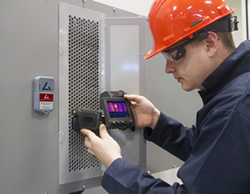Infrared windows – it’s a question of standards
The minimum requirements necessary for certifying a product to UL standards are usually sufficient to ensure the safe and reliable operation of the product, correct? Well, in the case of an infrared (IR) window this is not necessarily true as specific application details must be factored in before its use can be deemed ‘safe’. Martin Robinson, CEO of IRISS, offers a guide through the certifications which apply to infrared windows.
UL is a US-based, Nationally Recognised Testing Laboratory (NRTL) and worldwide safety consulting and certification company that performs safety testing. UL is the only organisation to have a defining standard for infrared windows called UL 50V. These devices are basically data collection ports for infrared inspection by thermal imaging cameras that are designed to allow electrical inspections to be conducted with the utmost safety when the system is under load. They ensure the electrical enclosure remains in a ‘safe and guarded condition’ so the risk of arc flash or electrocution injury is eliminated.
Consider the bigger picture
Not all infrared windows were created equal. Hence, anyone specifying an IR window needs to dig deeper than the UL 50V standard to be 100% confident in the suitability of the chosen window type. This base line standard simply verifies that the window provides a means for passage of infrared radiation but it also carries an important caveat.

UL 50V specifically states ‘meeting the requirements for this standard does not assure the window is suitable for use in any application and that suitability for continued use requires additional evaluation as to the performance characteristics necessary for the installation.’
So, what other certifications should you look for when specifying an infrared window? The following provides more detail in defining the functionality and, more importantly, the safety aspects required before attempting to modify an electrical enclosure in any way.
UL/NEMA 50E: These are environmental standards which apply to electrical enclosures that are intended to be installed and used in non-hazardous locations. These include enclosures for indoor locations only (NEMA types 1, 2, 5, 12, 12K and 13) and enclosures for both indoor and outdoor locations (NEMA types 3 and 3R). NEMA ratings can be self-certified when the manufacturer has third party tests to support the assigned ratings. More common to Europe are Ingress Protection (IP) ratings that can be mapped to equivalent NEMA enclosure ratings with the fundamental difference that IP ratings must be tested and certified by a third party lab.
UL 508: These requirements cover industrial control panels intended for general industrial use, operating at 1,500V or less. This equipment is intended for installation in ordinary locations, in accordance with ANSI/NFPA 70, where ambient temperatures do not exceed 40°C maximum.
UL 746C: UL 746C is a standard to test performance of polymeric (plastic) components and identifies the ability of a window to withstand impact or flame, an important consideration in the industrial environment.
UL 1558: UL 1558 is relevant to viewing panes and IR windows fitted into metal enclosed, low voltage (<600V) power circuit breaker switchgear assemblies. The standard requires the impact resistance of an assembly to be tested with the window closed - an essential criteria is that a 12.7mm diameter rod should not be able to pass through the window or cover.
IEEE C.37.20.2 section a.3.6: This standard and test procedure for viewing panes mounted in electrical equipment with ratings above 1kV requires viewing panes to withstand both impact and load tests. Unlike UL this does not give any dispensation for material composition of the IR viewing window or whether or not covers are fitted.
The test is simple. It requires that both sides of the IR viewing window be subjected to impact and load and that neither side can crack, shatter or dislodge. For crystal optic-based IR windows, this is a requirement that is impossible to meet.
IEC 62271-200: This provides a controlled arc flash test for 52kV and below on metal enclosed switch gear. The test is performed at 6kV using a current of 31.5KA for a duration of 0.5 seconds. The procedure determines the amount of pressure and heat installed components on switchgear can survive and still maintain integrity.
It should be noted that an ‘arc tested’ or ‘arc resistant’ rating can only be given to a completed assembly and not a single component within that assembly. Electrical cabinet designs and dimensions are infinite and we cannot use data from one cabinet design to another design unless they are identical in every way.
This is the reason why components, such as IR windows, can never carry a generic arc rating and must be subject to standard industry tests to confirm they meet the mechanical strengths and environmental properties for each electrical cabinet or assembly to which they are being fitted.










